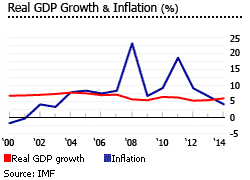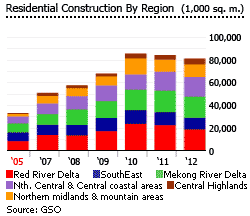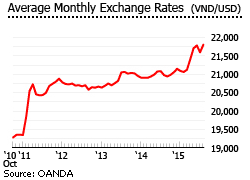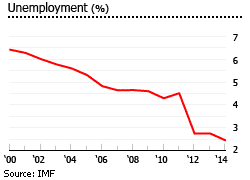Vietnam’s housing market now open for business
Vietnam’s property market is heating up, thanks to strong economic growth, and a growing middle-class, after almost five years of a housing slump - but most important is the new Housing Law and the Law on Real Estate Business. These came into effect in July 1, 2015, and allow foreigners and overseas Vietnamese to legally own, sell and transfer real properties.
The market is not yet "really hot" according to some - but it is heating up.
The new Housing Law has potentially enormous significance.
First, it removes critical obstacles to foreign property ownership. Foreigners who have been granted a Vietnamese visa, plus foreign investment funds, banks, Vietnamese branches and representative offices of overseas companies can now purchase residential property.
Foreigners can now own all types of properties, including condominiums and landed property such as villas and townhouses. The properties owned by foreigners can be sub-leased, inherited and collateralized.
Second, overseas Vietnamese who have maintained their Vietnamese citizenship will be treated like locals and are permitted to own unlimited property in their own names.
It is estimated that about 70% of the 4 million overseas Vietnamese around the world still maintain their original citizenship.
Until now, Viet kieu (overseas Vietnamese) and foreigners could only buy one apartment in Vietnam each. The conditions were strict, favouring only those married to Vietnamese nationals, holding managerial positions, or having contributed to the country. These criteria enabled only around 130 foreigners, out of around 80,000, to buy an apartment in Vietnam.
The revised housing law is revitalizing the property market and sending a broader message that Vietnam is open for business. “The government is looking at ensuring that Vietnam continues to be competitive, continues to be attractive to foreign investors, and to create an environment where business can thrive,” said David Lim of ZICOLaw Vietnam.
"There are 4.2 million Vietnamese overseas and about 30,000 foreign executives working here long-term," said Le Hoang Chau of Vietnam´s Real Estate Association. "That shows potential for a bright future."
"From my own analysis, from now till the end of 2015, the domestic real estate market will be getting hot because foreign capital flowing into the market is quite huge," said Dr. Nguyen Tri Hieu of An Binh Commercial Bank. "In particular, at the end of the year, the community of overseas Vietnamese who want to buy houses in big cities will be very high."
In Ho Chi Minh City, Vietnam’s most populated city, sales volumes in H1 2015 have exceeded total sales during 2014. “I can sell about three to five units per month now, much better than before, when I could only sell the same in the whole year,” said Dung, a property broker.
Prices of high-end residential properties increased 3.2% q-o-q in Q2 2015, according to CBRE Vietnam.
In Hanoi, Vietnam’s capital, the average price of newly launched high-end condominium units rose by 2% during the year to Q2 2015, while prices of low-end condo units increased 3%, according to Colliers International. During the latest quarter, prices of new condo units increased 1% in Q2 2015.
And several high-end residential projects in Hanoi saw price rises of about 4% to 6% y-o-y in the first half of 2015, according to CBRE Vietnam.
The upward momentum in residential property prices in Hanoi was also supported by Savills World Research.
- The average price of existing townhouses increased 0.9% q-o-q in Q2 2015, to VND60.3 million (US$2,682) per sq. m.
- Villa prices rose by 0.1% to VND48.8 million (US$2,170) per sq. m. over the same period
- New apartment prices in Hanoi also increased 1% q-o-q in Q2 2015
- Prices of existing apartments rose by 2% q-o-q in Q2 2015
The national figures show greater diversity. In Tay Ho and Hoan Kiem, the average price of existing apartments rose by 7% q-o-q in Q2 2015. On the other hand, Ba Dinh and Dan Phuong saw the biggest quarterly decline of 4% over the same period.
Property prices are expected to continue rising during the remainder of the year. Vietnam’s economy expanded by 6.44% from a year earlier in the second quarter of 2015, the highest growth in five years, according to the General Statistics Office (GSO).
The economy is projected to expand by 6.2% this year, up from 6% in 2014, 5.4% in 2013, 5.2% in 2012, 6.2% in 2011 and 6.4% in 2010, according to government forecasts.
| HANOI’S RECENTLY COMPLETED CONDOMINIUM DEVELOPMENTS | |||
| Project | District | Total units | Average asking price (US$/sq. m.) |
| Hoa Binh Green City | Hai Ba Trung | 800 | 1,580 |
| Mandarin Garden | Cau Giay | 1,125 | 1,534 |
| Thanh An Tower | Thanh Xuan | 352 | 1,282 |
| Trung Kinh Complex, Home City | Cau Giay | 1,200 | 1,190 |
| Wartermark Ho Tay | Cau Giay | 128 | 2,280 |
| HP Landmark Tower | Ha Dong | 1,124 | 801 |
| Diamond Blue | Thanh Xuan | 200 | 870 |
| Source: Colliers International | |||
Local house price variations

Hanoi´s most expensive housing is in Cau Giay District, with average dwelling prices of around VND165 million (US$7,344) per square metre (sq. m.) in Q2 2015, according to Colliers International. Tay Ho District follows, with average dwelling prices of VND110 million (US$4,896) per sq. m. Me Linh District had the most affordable housing, at about VND11.2 million (US$499) per sq. m.

In Ho Chi Minh City, District 5 had the highest asking price for newly launched condominium units in Q2 2015, with a range of from US$1,400 to US$2,300 per sq. m. It was followed by District 2 (US$1400 to US$2,100 per sq. m.), Tan Binh (US$1,100 to US$1,700 per sq. m.), District 7 (US$900 to US$1,400 per sq. m.), Bin Thanh (US$800 to US$1,200 per sq. m.) and District 6 (US$600 to US$800 per sq. m.).
In HCMC, newly launched residential developments have the following asking prices:
- In Vinhomes Central Park, a high-end development located in Binh Thanh, villa prices averaged US$7,000 per sq. m.
- In Saroma, located in District 2, villa prices averaged US$2,000 per sq. m.
- In Pho Dong Village P.1, also situated in District 2, the average price of villas and townhouses stood at US$1,650 per sq. m.
Uncertainties in the implementation of the Housing Law
The generally quoted figure is that about 500,000 to 1 million overseas Vietnamese want to return to Vietnam to live. Of course, house prices in Vietnam are relatively cheap compared to other cities in Southeast Asia.
However there are some uncertainties. Circulars guiding the implementation of the new Housing Law have not been issued. In particular, the administrative procedures have not been simplified yet, and provisions on protection of the interests of investors of real estate projects are not yet available.
However according to the law developers must obtain guarantees from Vietnam-licensed credit institutions, and should they fail to hand over the residential houses as agreed in the sale, lease out/sale contract, the purchaser or lessor may ask the guarantor for the payments they have made.
Finally foreigners can transfer money to Vietnam to buy a house - but it is not yet clear that they are allowed to transfer money abroad after they sell or transfer their houses in Vietnam, or to borrow from banks in Vietnam to purchase houses.
For foreign individuals the house ownership period is 30 years, but it can be extended. The new law also limits foreigners from owning more than 30% of a single apartment building, or more than 350 houses and apartments in a ward, a subdistrict-level administrative area. The Ho Chi Minh City Real Estate Association has objected to this, because of the concentration of foreigners in key districts.
HCMC’s surging demand

Demand is now surging. In HCMC, total dwelling sales rose by 12% in Q2 2015 from the previous quarter and by 116% from a year earlier, according to Savills. Townhouses accounted for about 82% of the total sales transactions.
Apartment sales were up 96% to 5,000 units in Q2 2015 from a year ago, the highest level since Q4 2010. District 2 dominated the market, with about 28% share of the total sales, followed by Binh Thanh with 15%. Sales volume of Grade B apartments surged 44% q-o-q in Q2 2015 while sales for Grade C apartments remained stable.
Perpetual Lease
In theory, freehold land does not exist in Vietnam. Land can only be leased, even by Vietnamese; though in reality many leases seem to be for indefinite terms. “Buying” land is technically a transfer of leasing rights. The creation of a perpetually renewable lease means that Vietnam now has one of the most open property markets in Asia.
Housing supply continues to rise
Housing supply in Vietnam is now rising rapidly. In Hanoi, about 19,000 condominium units are expected to enter the market, mainly located in the West and the South West, according to Colliers. In addition, four new villa and townhouse projects will be completed by end-2015, according to Savills.
In Hanoi the total stock of dwellings (villas and townhouses) was about 30,100 units in 110 projects in Q2 2015, according to Savills World Research. Of the total stock, 1,030 units were newly-built while 29,060 units were existing houses.
By the end of 2015, four new projects of villas and townhouses in Hanoi are expected to enter the market, according to Savills. Three projects will supply about 390 villas and townhouses.
In addition, the condo market is also expanding sharply. Five new large condominium projects came into the Hanoi market in Q2 2015, adding about 3,000 units, up 3% from the previous quarter. These residential projects included Hoa Binh Green City, Trang An Complex, Imperia Garden, The Manor Central Park, and FLC Garden City.
Hanoi’s luxury segment is concentrated in Hoan Kiem and Hai Ba Trung District, the capital city’s business hubs, with a total stock of about 2,200 units in Q2 2015.
In HCMC, about 15,500 condominium units are expected to come to market in 2015, mostly outside the CBD (such as District 2, District 4, District 7 and Binh Thanh) due to insufficient land availability, according to Colliers. Moreover, 1,250 villas and townhouses are expected to be launched in the coming months, according to Savills. The supply of new villas and townhouses was about 1,140 units in Q2 2015, up by 3% from the previous quarter and by 216% from a year ago, according to Savills. Most of the dwelling stocks were located in Go Vap, Binh Tan and Binh Chanh District.
The supply of newly launched condominium units in HCMC surged 70% q-o-q in Q2 2015 to reach about 25,000 units, according to Colliers International. The high-end segment accounted for 62% of total supply. Most of the newly-built condo units that recently entered the market come from the following developments:
- Gateway Thao Dien in district 2 (high-end project)
- Everich Infinity in district 5 (high-end project)
- Sky Center in Tan Binh District (high-end project)
- An Gia Riverside in district 7 (mid-end project)
- Saigonres Plaza in Binh Thanh (low-end project)
| FUTURE SUPPLY UNDER CONSTRUCTION | |||
| Project | Location | Type | Completion |
| FLC Garden City | Tu Liem, Hanoi | Villa/Townhouse | 2016 |
| Trang An Complex | Cau Giay, Hanoi | Villa/Townhouse | 2017 |
| Goldsilk Complex | Ha Dong, Hanoi | Townhouse | 2017 |
| Evelyne Garden | Ha Dong, Hanoi | Villa/Townhouse | 2017 |
| The Manor Central Park | Thanh Tri, Hanoi | Villa/Townhouse | 2018 |
| Pho Dong Village P.1 | District 2, HCMC | Villa/Townhouse | 2016 |
| Saroma | District 2, HCMC | Villa | 2016 |
| Vinhomes Central Park | Binh Thanh, HCMC | Villa | 2017 |
| Source: Colliers International | |||
Apartments are now increasingly becoming popular
In Hanoi, the number of newly-built apartments released onto the market surged 24% during the year to Q2 2015, to 13,400 units, according to Savills World Research. The capital’s total apartment supply had already reached 121,400 units in Q2 2015.
In HCMC, launches of new apartments surged 138% y-o-y to more than 9,700 units during the year to Q2 2015, the highest level in five years, according to Savills. Overall, there were about 26,000 apartment units available in Q2 2015, a significant increase of 27% from the previous quarter and 72% from a year earlier. In addition, about 59,200 apartment units from 90 existing and future projects are expected to enter the market in the next two years. Most of which are concentrated in District 9.
Under-served low-end market
According to RNCOS, a global market research company, many Vietnamese do not have their own houses and more than 70% of households live in temporary wooden houses. RNCOS estimates that Vietnam is deficient of about 20 million permanent housing units.
The demand for affordable houses is now outstripping supply, as residential development has largely focused on high-end customers.
Decision 996/QD-TTg
Prime Minister Nguyen Tan Dung signed Decision 996/QD-TTg in June 2014 to increase the number of social housing projects in Hanoi, while ending construction of commercial housing projects in the city centre, especially the four downtown districts of Dong Da, Hoan Kiem, Ba Dinh, Hai Ba Trung and part of the southern Tay Ho District. Priorities will be given to construction of urban areas and residential areas in the city´s outskirts.
This year, the government expects to spend more than VND6.7 trillion (US$321 million) to construct about 1.8 million sq. m. of floor space (20,000 apartments) for retired civil servants, and another 2 million sq. m. of floor space for workers and students.
The memory of a housing bust (2009-2013)
Vietnam witnessed a prolonged housing catastrophe in recent years, mainly due to the impact of the global crisis. Property prices plunged by double-digit figures. The government was embarrassed, the banks were bankrupt, and the economy slowed sharply.
There were a staggering number of unsold housing units in Vietnam’s two biggest cities. Many residential projects have stalled in mid-construction (an example being the Saigon Residence, a high-end residential building in Ho Chi Minh’s centre). Many property developers have delayed launching projects.
The banking system effectively collapsed. One out of every ten loans in the banking system had stopped paying, according to the central bank. However, Fitch Ratings believes the percentage of bad loans could have been much higher.
In an effort to bolster demand:
- A VND5 trillion (US$222 million) credit package was given to homebuyers by the Vietnam Bank for Industry and Trade (Vietinbank).
- The government bought US$8 billion of non-performing loans, especially from the real estate sector.
- The government provided the real estate market with a US$1.4 billion stimulus package in 2013 and placed stricter financial requirements on property developers.
- The State Bank of Vietnam (SBV), the country’s central bank, slashed the refinance rate and discount rate several times.
- An exemption of about 10% of the value added tax (VAT) for home buyers is now being proposed by the Housing and Real Estate Market Department.
Rental market expanding
The rental market has been expanding recently, as the number of customers asking for apartments to lease increases. In HCMC, occupancy rate was 84% in Q2 2015.
Moreover, supply of high-grade rental apartments is also increasing. In HCMC, there were more than 3,000 serviced apartments in the market from 79 projects in Q2 2015, with District 1 accounting for about 40% (1,700 units) of the total supply.
| SERVICED APARTMENTS UNDER CONSTRUCTION, HCMC | ||||
| Project | District | Grade | Total units | Expected completion |
| Cosmo Residence | 3 | B | 30 | 2015 |
| New Pearl | 3 | B | 120 | 2015 |
| Saigon Centre Phase 2 | 1 | A | 216 | 2016 |
| Saigon Ascott Waterfront | 1 | A | 222 | 2016 |
| Icon | 3 | B | 63 | 2016 |
| Source: Colliers International | ||||
Rental yields in Vietnam remain high, ranging from 6% to 7% in 2014, according to Chen Lian Pang of CapitaLand Vietnam. This is particularly true for high-end apartments in Hanoi and HCMC such as at Indochina Plaza Ha Noi, Dolphin Plaza and Starcity Le Van Luong.
Monthly rents for apartments in Vietnam almost doubled in 2014 from the previous year, to reach US$2,000 to US$4,000, according to CBRE Vietnam. However the rent rise then paused, and in Q2 2015, the average monthly rent for apartments in HCMC stood at US$23 per sq. m., unchanged from the previous quarter, but down by 2% from a year earlier, according to Colliers International.
In Q2 2015:
- For Grade A apartments, the average monthly rent was US$31 per sq. m.
- For Grade B apartments, the average monthly rent was US$25 per sq. m.
- For Grade C apartments, the average monthly rent was US$16 per sq. m.
Underdeveloped mortgage market

The Vietnamese mortgage market is still relatively underdeveloped, with majority of homebuyers paying in cash. In an effort to boost the housing market, developers are now starting to work with banks to offer mortgages to buyers.
However, high interest rates and strict loan procedures still hinder the local mortgage market from flourishing. The loan-to-value (LTV) ratio rarely exceeds 50% of the appraised value of the property. The term period is usually 15 years.
Though interest rates are falling in recent years, they remain relatively high. In 2014, the average lending rate stood at 10%, down from 10.5% in 20 13, 14% in 2012, and 17% in 2011.
As a result, mortgage interest rates in major banks are also falling. Techcombank’s mortgage rate dropped to 7.99% in March 2015, from 9.49% in January 2015; Vietcombank’s mortgage rate fell to 7.5%, from 7.99%; and ACB’s mortgage rate fell to 7.5%, from 8.9%.
Devaluing the dong

Vietnam has pegged the dong to the US dollar for several decades, within a limited band of 1% to 2% - an important measure used by the SBV to maintain macroeconomic stability.
However the State Bank of Vietnam (SBV), the country’s central bank, has devalued the dong twice so far this year, most recently in May, in an effort to buoy slowing exports.
The exchange rate is expected to remain unchanged for the rest of the year. “Between now and the year end, it´s not necessary to raise the issue of devaluing the Vietnamese dong, especially when the State Bank has full ground to forecast that inflation in the whole of 2015 will be at 3% instead of 5% as per the government´s target at the start of the year," said Deputy Governor Nguyen Thi Hong.
Three decades of uninterrupted growth
In the second quarter of 2015, Vietnam’s economy expanded by 6.44% from a year earlier, the highest growth in five years, according to the country’s General Statistics Office (GSO).
Vietnam has experienced three decades of uninterrupted growth, based on figures from the International Monetary Fund (IMF).
- 1981-1990 – average real GDP growth of 5.9% per year
- 1991-2000 – average real GDP growth rate of 7.6% annually
- 2001-2010 – average real GDP growth rate of 6.8% annually

In 2014, the economy expanded by a robust 6%, after growing by 5.4% in 2013, 5.2% in 2012, 6.2% in 2011 and 6.4% in 2010, according to the IMF. The economy is projected to expand by another 6.2% this year, based on government forecasts.
The Vietnamese government is now in the process of easing business regulations and pursuing a long-running privatization drive, to boost growth further.
Unemployment remains low. In Q2 2015, the country’s unemployment rate was 2.44%, from 2.22% in Q1 2015, 2.1% in Q4 2014, 2.17% in Q3 2014, 1.84% in Q2 2014, and 2.21% in Q1 2014, according to the GSO. From 6.42% in 2000, the overall jobless rate continuously dropped to 2.45% in 2014, according to the International Monetary Fund (IMF).
In August 2015, the inflation rate stood at 0.6%, down from 0.9% in the previous month and far below the 4.31% inflation during the same period last year, according to the GSO. The country’s inflation rate for 2015 is projected at 3%, below the government’s initial target of 5%.